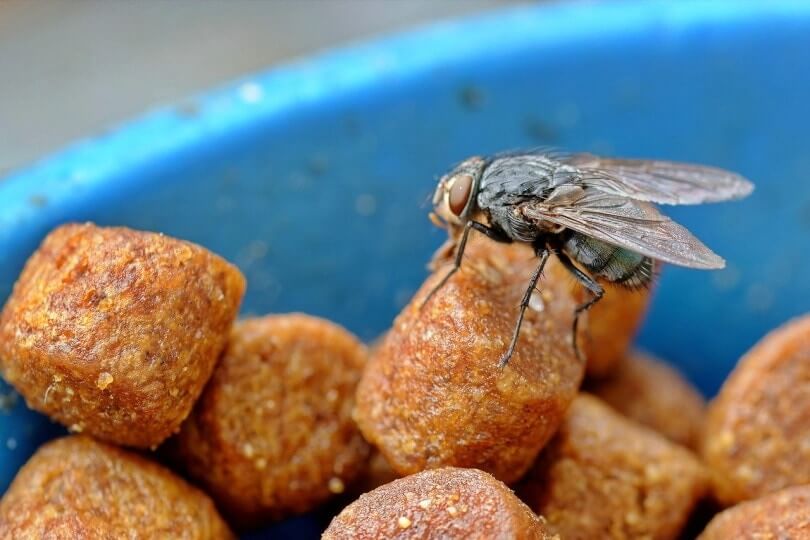Having a beloved cat that spends time outdoors brings a lot of joy, but it also introduces some challenges, like dealing with pesky flies. These insects aren’t just a nuisance; they pose serious health risks to your furry friend. Flies can carry diseases that might cause vomiting, diarrhea, and fever in cats, with toxoplasmosis and salmonellosis being two common culprits.
Let’s dive into how to keep flies off outdoor cat food, ensuring your pet stays happy and healthy.
Why Keeping Flies Away Matters
Flies are more than just an annoyance. They can quickly contaminate your cat’s food with bacteria and other pathogens. If your cat eats food that flies have touched, it might ingest harmful microorganisms, leading to health problems. So, ensuring that your cat’s food is fly-free is crucial for its well-being.
How To Keep Flies Away From Cat Food
Here are some of the best strategies to keep flies away from your outdoor cat’s food. These methods are practical and easy to implement, whether you live in an urban setting or the countryside.
The Cover-Up Strategy
One of the simplest and most effective ways to keep flies away from your cat’s food is to cover it up. Invest in some affordable food covers or use a clean, upside-down bowl to protect your kitty’s meal, plastic bags with drawstrings, or plastic containers with tight lids work wonders. This not only keeps flies away but also keeps the food fresh for longer.
Pro Tip: Try using a vacuum-sealed bag for extra protection. These bags remove air and help keep food fresher longer, reducing the chance of attracting flies.
Elevate the Plate
Keeping the food off the ground can make a huge difference. Place the food bowl on a raised surface, like a table or a shelf. This makes it harder for flies to reach the food and gives your cat a more comfortable eating experience.
Creative Idea: Use a small outdoor table or a sturdy plant stand. Not only does this keep flies away, but it also keeps other critters from getting into the food.
Fly-Free Zones
Creating a fly-free zone for your cat is easier than you might think. Scatter-free traps are an excellent way to catch flies before they become a problem. These traps use bait to lure flies in and then trap them on sticky paper or in a container.
Eco-Friendly Tip: If you’re in a rural area, consider using traps that don’t scatter fly remains. This helps keep the environment clean and reduces the impact on other wildlife.
Good Old Fans
Flies are not the biggest fans of strong breezes. Place a fan near your cat’s feeding area to create a constant airflow. This makes it difficult for flies to land and enjoy a meal of their own. Plus, it keeps the area cool for your kitty on hot days!
Regular Clean-Up
Regularly cleaning the feeding area can significantly reduce fly attraction. Flies are drawn to leftover food and dirty bowls, so make sure to clean up after each meal.
Quick Fix: Use warm, soapy water to wash the bowls and the surrounding area. This not only keeps flies away but also ensures your cat’s eating area is hygienic.
Natural Solutions
1. A Dash of Vinegar
Vinegar is a fantastic natural repellent. Mix a solution of equal parts water and white vinegar in a spray bottle. Spritz this around your cat’s food bowls and feeding area. The strong smell will deter flies without harming your cat or their appetite.
2. Essential Oils
Essential oils like lavender, eucalyptus, and citronella are great for keeping flies at bay. Place a few drops on cotton balls and strategically position them near your cat’s feeding area. The pleasant aroma will make the flies think twice about invading your cat’s meal.
3. Citrus Magic
Flies have an aversion to citrus scents. Cut up some lemon or orange peels and place them around your cat’s food dishes. Not only will this add a fresh aroma to the area, but it’ll also discourage flies from landing.
4. Cayenne Spice Power
Cayenne pepper is not just a spice for your dishes; it’s also a great fly deterrent. Sprinkle a bit of cayenne pepper around your cat’s food bowl, and flies will think twice before approaching. Just make sure your kitty doesn’t get too curious!
5. Fly-Repellent Plants
Consider adding some fly-repellent plants, such as basil, mint, or marigolds, to your home or garden. These plants naturally deter flies and can create a protective barrier around your cat’s eating space.
DIY Fly Traps
If flies persist, it’s time to get crafty with some homemade fly traps.
1. The Plastic Bag Trick
Take a clear plastic bag, fill it with water, and hang it near your cat’s food area. The water refracts light and confuses the flies, making them stay away.
2. Apple Cider Vinegar Trap
In a shallow dish, mix apple cider vinegar with a drop of dish soap. Cover it with plastic wrap and poke small holes in it. Flies will be attracted to the vinegar, get trapped in the soapy solution, and meet their doom.
3. Jar with Rotting Fruit
Place a piece of rotting fruit, like a banana peel or apple core, in a jar with a narrow neck. Flies will be lured in by the scent but will struggle to find their way out.
Switch to Dry Cat Food
Flies are particularly attracted to the strong scent of wet cat food. If you’re dealing with a persistent fly problem, consider switching to dry cat food. Dry kibble produces fewer odors and can be stored in an airtight container for added protection against flies.
Use Flea Medicine
While flea medicine is primarily used to control fleas, it can also help keep flies away. Flea treatments like spot-on products not only repel fleas but also other pests, including flies. Ensure you use a product suitable for your cat and follow the instructions carefully.
Feed Smaller Portions
Feeding your cat smaller portions that it can eat in one sitting can help reduce the amount of time food is left out, thereby reducing the chances of flies contaminating it. This also helps keep the food fresh and more appetizing for your cat.
Establish a Feeding Schedule
Establishing a feeding schedule for your cat is another strategic approach. Avoid leaving food out for extended periods and stick to a consistent schedule. When your cat knows when to expect their meals, you can minimize the time food is left unattended, reducing the window of opportunity for flies to gather.
Does Cat Food Attract Flies?
Yes, cat food can attract flies, especially if it’s wet food or if it’s left out for extended periods. Flies are attracted to the smell and will lay eggs on the food if given a chance. This is why it’s so important to keep the feeding area clean and the food covered.
What Happens When Flies Land on Cat Food?
It’s pretty gross, but it’s important to know what happens when flies land on your cat’s food. Flies can lay eggs in the food, which can hatch into larvae (maggots). These larvae can carry bacteria and other pathogens that can make your cat sick. Symptoms of fly-borne illnesses include vomiting, diarrhea, and fever. In severe cases, your cat might need to see a vet.
Can Flies Lay Eggs on Dry Food?
Flies are less likely to lay eggs on dry food, but it’s not impossible. They prefer moist environments, but if the dry food becomes damp or if there’s any moisture around, they might still lay eggs. Keeping dry food in a sealed container is a good preventative measure.
What Happens If a Cat Eats Food with Fly Eggs?
If your cat eats food with fly eggs, there’s a risk they could ingest harmful bacteria or parasites. In most cases, the stomach acids of the cat will kill the eggs. However, there’s still a chance of gastrointestinal issues. Keep an eye on your cat for any signs of illness, and consult a vet if you’re concerned.
Can Eating a Fly Make a Cat Sick?
Yes, eating a fly can make a cat sick. Flies can carry parasites like tapeworms, which can infect your cat if ingested. Additionally, flies can harbor bacteria that can cause illness. If your cat regularly catches and eats flies, consider speaking with your vet about parasite prevention.
What to Do Next
If you’ve done everything you can to keep flies away and they’re still a problem, it might be time to call in some help. Here are a few steps you can take:
- Consult a Veterinarian: If your cat is showing symptoms of illness, don’t wait. Call your vet and get professional advice. They can help you determine if flies are the cause and recommend treatment options.
- Professional Pest Control: Sometimes, you might need to call in the pros. Pest control companies can offer solutions that are safe for pets and highly effective at getting rid of flies.
- Regular Maintenance: Keeping up with regular cleaning and maintenance is key. Make sure you’re consistently implementing the tips mentioned above to keep flies away in the long run.
Conclusion
With these tips and tricks up your sleeve, you’ll have no trouble keeping flies away from your cat’s food. Remember, it’s not just about convenience; it’s about your cat’s health and happiness. So go ahead and reclaim mealtime for your furry friend, and enjoy a fly-free feeding experience together. Your cat will purr with gratitude, and you can finally say goodbye to those pesky flies for good.
Happy fly-free feeding!



